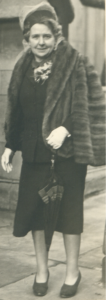Dorothy Agnes Sheepshanks was born in 1889, one of seventeen children (twelve of whom survived to adulthood) of John Sheepshanks vicar of Anfield and his wife Margaret (née Ryott). Both came from minor Yorkshire gentry families (the Ryotts were distant descendants of Oliver Cromwell). In his youth Sheepshanks had worked as a missionary in British Colombia, returning home across the Pacific, through China, Mongolia and Siberia. Anfield in the 1880s it was a tough urban parish, riddled with sectarian hatreds fomented between Irish Catholic and Protestant Evangelical communities. In 1892 John Sheepshanks was suddenly plucked from this environment to become Bishop of Norwich. The promotion was due to William Gladstone, whose family came from nearby Cheshire. Sheepshanks shared Gladstone’s Liberal High Church beliefs, his love of Classical scholarship and his missionary concern for the poor. Dorothy inherited these attitudes, but added to them a concern for women’s rights, and followed in the footsteps of her eldest sister Mary Ryott Sheepshanks, a committed suffragette and feminist with an international reputation.
Dorothy Sheepshanks attended St Felix’s School on the Suffolk coast, where her family regularly spent their summer holidays. In 1908 she won a scholarship to Somerville College, Oxford,  which would become her intellectual home. After coming down from Oxford, Dorothy initially settled with her brother William in Hampstead, and worked for various social organizations such as the Workers Education Association, the Women’s Trade Union League and the Women’s Coop Guild. (A very civic-minded family, youngest brother Thomas later became the senior civil servant responsible for inaugurating the National Health Service in 1947. According to family accounts, Thomas grossly underestimated – by ten times – the number of patients who would rush to the doctor after the inauguration of free medical care.)
which would become her intellectual home. After coming down from Oxford, Dorothy initially settled with her brother William in Hampstead, and worked for various social organizations such as the Workers Education Association, the Women’s Trade Union League and the Women’s Coop Guild. (A very civic-minded family, youngest brother Thomas later became the senior civil servant responsible for inaugurating the National Health Service in 1947. According to family accounts, Thomas grossly underestimated – by ten times – the number of patients who would rush to the doctor after the inauguration of free medical care.)
During World War I, William joined the Rifle Corp and was killed in Belgium in 1917. In 1922 Dorothy married Thomas Muir, a mild-mannered colleague of her brother who worked at the Home Office. They had two children, Christina (b. 1923) and Alastair (b. 1927), and during this time Dorothy wrote her first major literary work, the two-volume A History of Milan Under the Visconti (1924).
Disaster struck when Thomas Muir died of cancer in 1932, leaving Dorothy to bring up two small children in the depths of the Great Depression. Ever practical, shey fell back on Oxford and set about building an academic career, taking out a twenty-year lease from St John’s College of 2 Bradmore Road, Norham Gardens, where many dons and their families lived. Dorothy’s starting point was preparing candidates for the Oxford University entrance; she then became an outside specialist tutor to whom colleges might refer undergraduates. According to family sources, Machiavelli and His Times was written with the Political Thought and Renaissance Special Subject papers of the Oxford History School in mind. Dorothy also served as an examiner for School and Higher Certificate exams (the ancestors of O and A Levels), and further supplemented her income by writing historical biographies. Her children attended Oxford, and son Alastair went on to be a senior executive in ICI.
On retirement Dorothy bought a house in Southwold and set about replicating many of the features from her childhood: the dining room had Willow Pattern wallpaper, the garden was inhabited by tortoises and she built a hut christened ‘Horse Chestnut House’ in the garden. A memoir of her early days, Lift the Curtain, was published in 1955, as well as A Historical Guide to Southwold Parish Church, which saw 18 editions published between 1955 and 1983.
Under the moniker D. Erskine Muir, Dorothy wrote three accomplished detective novels: In Muffled Night. (1933), Five to Five (1934) and In Memory of Charles (1941). Each employed a true crime as the basis for the fictional plots, spinning original solutions to unsolved mysteries. In Muffled Night also draws on her experiences from childhood, with the setting a house in ‘Highstead’ (a disguised form of Hampstead), furnished in dark 1880s style, rather like the Anfield vicarage and the Bishop’s Palace. Even the caption ‘Christ is the head of this house, the unseen guest at every meal, the silent listener to every conversation’ appears in both places. The character James Murray is arguably a fictional representation of the more disagreeable religious aspects of John Sheepshanks’ regime at Norwich.
Despite critical praise by Dorothy L Sayers amongst others, her books were never published in the United States and faded from view in the UK as Dorothy Erskine Muir returned her attention to historical non-fiction work It is a delight to see them back in print.